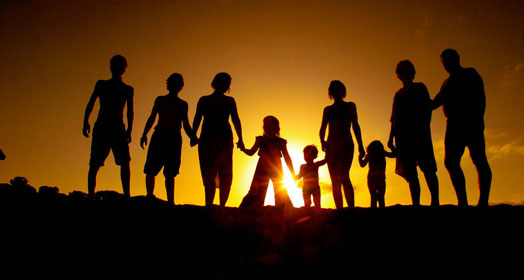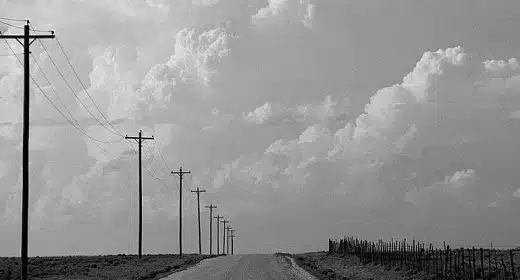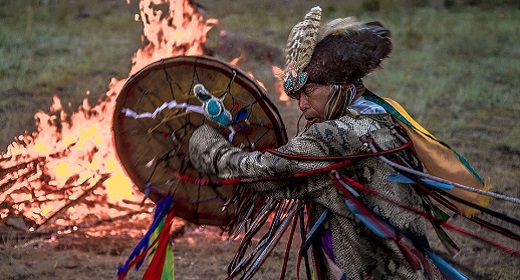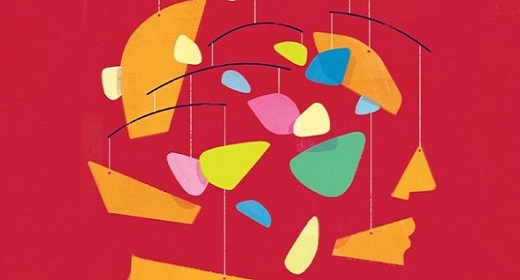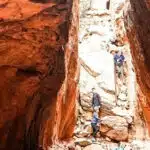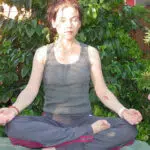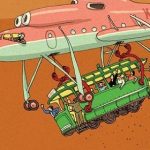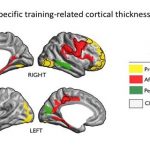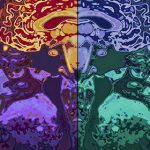by Paul Levy: The following is excerpted from Awakened By Darkness: When Evil Becomes Your Father…
Spiritual awakenings oftentimes get precipitated by experiences of wounding, abuse and trauma, which is to say that in a genuine spiritual awakening there is often a co-joining of healthy and pathological factors. The idea is to nourish the healthy aspects of the process so that they become stronger, while allowing the pathological factors to naturally fall away as they become integrated into the wholeness of the newly emerging psyche. To quote the great Hindu saint Ramakrishna, “How to get rid of the lower self? The blossom vanishes of itself as the fruit grows, so will your lower self vanish as the divine grows in you.”
Being wounded almost always initiates and catalyzes the “shamanic archetype” to begin to form-ulate and crystallize itself in the unconscious. Shamanism is the root from which humanity’s various spiritual disciplines have issued; the earliest origins of modern psychotherapy known to history lie in archaic shamanism. When the shamanic archetype is activated, it precipitates a deeper part of the psyche to become mobilized, as people enacting the shamanic archetype journey deep inside themselves, flying on the wings of their creative imagination to become familiar with and address what has gotten activated within them. The shamanic archetype becomes catalyzed in us by a severe emotional and spiritual crisis, oftentimes organically growing out of unresolved abuse issues from childhood—this was certainly true for me.
The shamanic archetype is one of the major processes currently animated in the collective psyche of our species. We’d have to be truly “disturbed” if our emotions aren’t disturbed by the diabolic and dark shadow forces playing out their polarizing, manipulative and exploitive agendas in our world. How we hold what has gotten triggered within us as we both witness and participate in these distressing dramas determines whether the latent shamanic archetype within us manifests in service of our—and our planet’s—healing or not. Just as dreams are the unconscious’s way of balancing a one-sidedness in an individual’s psyche, the shamanic archetype is the dynamically evolving pattern of healing that is being constellated in the collective unconscious as a compensatory response to the trauma and abuse playing itself out on the world stage.
A person would never—if they were in their right mind—choose to be a shaman. It’s not the sort of thing that someone takes a weekend workshop or a class and then becomes a shaman. Becoming a shaman is a vocation, which is to say that it is something one is “called” to do; this calling is typically conceived of as coming from the spirits, i.e., from an autonomous spiritual factor deep within the psyche. Etymologically, the word “calling” has to do with hearing a voice—the voice of the other within ourselves—with which, like a living person, we develop an ongoing and deepening relationship. This inner figure has from time immemorial been referred to by a multiplicity of names—our muse, ally, guiding spirit, angel, genius and daemon, to name but a few. Attracting many names to itself is typical of something numinous; one name doesn’t quite “do it.”
If it is a true calling and we resist, however, we can fall ill, go crazy or even die; the point is that the stakes are high, and being called to shamanize is something to take seriously. It necessarily involves making a descent into the underworld of the unconscious—into the netherworld of the shadow—where we have to confront our own dark side and madness; this is why in a shamanic initiatory experience, the potential shaman looks like they’re having a psychotic break. A Siberian shaman reminds us, “If you find the spirit of madness, you will begin to shamanize.” Becoming a shaman is not for the faint of heart; the initiate typically has to go through a death experience, whose other side, if all goes well, is rebirth. The suffering involved—which is actually a purification—is intense. Speaking of what he calls “shamanic suffering,” Holger Kalweit, author of Dreamtime and Inner Space: The World of the Shaman, writes that the suffering a potential shaman goes through is “a suffering intense enough to kill.” I can totally relate; after the abuse from my father, it was as if the doors of my unconscious opened up, unleashing formidable energies that easily could have killed me.
A key part of the shaman’s initiation is to come to terms with evil. Mircea Eliade refers to shamans as “pre-eminently the antidemonic champions; they combat not only demons [who Eliade refers to as “the true enemies of humanity”] and disease, but also black magicians…. What is fundamental and universal is the shaman’s struggle against what we could call ‘the powers of evil.’” In my life, my encounter with the evil that came through both my father and psychiatry were the forms that my descent into the underworld took; if I hadn’t re-contextualized these experiences as being part of a deeper shamanic initiatory process, I would have been stuck in and personally identified with these experiences in their literal rather than symbolic form, possibly for the rest of my life, which would have been truly tragic. Von Franz wrote, “The symbolic inner experiences which the Shaman lives through during his period of initiation are identical with the symbolic experiences the man of today lives through during the individuation process…curing the soul of individuals and collective states of possession is really the principal task of the Shaman.” The mission of the shaman is to heal—both individually and collectively—the state of possession by unconscious psychic forces of the members of their community, as well as the community as a whole.
In indigenous, shamanic communities, the role of the shaman does not exist in isolation, but as a role that the community collaboratively dreams up for the health and sanity of the wider community. The role of the shaman is relational in nature—only taking on its meaning in relation to others as well as the surrounding environment—not something that exists independent of the field in which the shaman lives. Being a role in the field, in the ideal sense the position of shaman need not be monopolized by or restricted to one person; a shaman is a role that any and everyone can pick up as we become more creative and fluid within ourselves. In a genuinely healthy community, roles are very fluid, which is to say—in a form of “collective shamanism”—the role of the shaman can potentially be played out at various times by each of its members. Because the role is being shared by all of its members, different people can play the shamanic role without necessarily having to descend into the depths of hell; they are required, however, to self-reflectively deal with how their own unconscious darkness is contributing to the collective shadow that is getting dreamed up in and through the community.
We are all potentially “shamans-in-training,” in the sense that we are all being called—both individually and collectively—to deal with the darkness that seems to be ruling our world. The formless archetype of the shaman/healer is thirsting for sentient instruments to express and actualize itself in embodied form. Recognizing, and saying “Yes” to the deeper shamanic calling that is pulsing through our veins inspires us to breathe life into and incarnate the figure of the shaman who lives within us. We are being invited by the universe to step into our shamanic “garments” and consciously participate in our own evolution. Instead of our ritual implements being drums and rattles, however, as “modern-day shamans” our accessories might be something like the keyboard of a computer or the tools of multi-media, as we work to inspire change in the underlying consciousness of the field by a keystroke or the creative use of a video camera or website. Co-operating with our deeper shamanic calling constellates the universe to support us in our endeavor, as the universe itself is the sponsor of our calling. Assenting to our calling gets us “in-phase” with ourselves such that we become our own best ally.
The psyche is easily dissociable; due to trauma it can readily fragment into seemingly separate parts. Being wounded creates a dissociation in us, in the sense that we dis-associate from and lose connection with parts of ourselves. People of shamanic temperament, however, are able to turn the psyche’s natural ability to dissociate to their advantage. They are able to purposely dissociate, which is very different from the unconscious pathology of dissociative disorder. The shaman’s ability to dissociate, and fluidly travel between different reference points within themselves helps them to re-member their dis-membered selves, as well as to retrieve the split-off, and hence unconscious, soul of the community.
A shaman often suffers from the plight of their people. Due to their “standing” at the gateway between the conscious and unconscious aspects of their own mind as well as the community at large, they are able—like a healing enzyme—to act as agents transforming and raising unconscious contents into conscious awareness, making these contents available to the community. I think of Jung—a deeply shamanic personality—who was afflicted with dreams and visions of bloodbaths and catastrophes in Europe which he wasn’t able to understand until soon thereafter the First World War broke out, and he realized that his personal experiences reflected the collective situation that was brewing in the cauldron of humanity’s unconscious.
People going through a spiritual awakening/shamanic initiation find themselves, as if living in an archetypal fairy tale, inhabiting a deeper mythic realm where everything that happens is in-fused with deeper meaning. This deeper meaning doesn’t come from outside of us; we are the arbiters of meaning—“meaning-generators.” Instead of being mute and having no say in things, our world is always speaking to us symbolically, speaking “through” things (so to speak); this can take a little while to interpret, integrate and to learn to navigate. The goal is to bring together the two worlds so that we can fluidly travel between the everyday world of ordinary reality and the deeper mythological, symbolic realm, a dimension which is always having its say—the question is whether we recognize what is being said. This is analogous to having a fluid back and forth, give and take relationship between the conscious and unconscious minds within ourselves.
A key part of the shaman’s vocation is to be able to “see” the spirits, which is to be able to recognize and develop relationship with the forces of the unconscious. Wetiko can be thought of as having its own spirit; this is why I am continually pointing out the importance of “seeing” how this spirit operates—out in the world, through others, via our relationships and within our own mind. Seeing “the spirits,” which von Franz points out is today simply called “the unconscious” takes away their autonomy and seeming power over us, while expanding the light of our consciousness in the service of individuation. The more individuated we become, the wider is our consciousness of the realm of the unconscious which spreads out before us in, as and through the world. To wake up to the dreamlike nature of reality is to realize that we are surrounded on all sides by the unconscious; dreams themselves are the unmediated expression of the unconscious. The process of becoming conscious doesn’t banish the unconscious, but rather, aids us in developing the trust to give ourselves over to it time and again, thereby learning how to receive its gifts of wisdom. When we shed light on the darkness of the unconscious, it’s not that all of its contents become illumined; rather, there becomes a more permeable boundary for the unconscious contents to emerge into consciousness, as well as for consciousness to step into the world of the unconscious.
The shaman is akin to and a kin of the figure of the artist. To quote anthropologist Carlton Coon, “Whatever else he may be, the shaman is a gifted artist.” Mythologist Joseph Campbell draws a parallel between artists and ancient shamans when, speaking about modern artists, he says that “the whole unconscious has opened up and they fall into it.” We continually deepen our individuation only insofar as we don’t cling to our conscious experience, but allow ourselves to submerge into the depths of the unconscious however and wherever it shows up, trusting that we will be able to creatively express—and hence, become conscious of—what is moving us. As Jung points out, “The unconscious no sooner touches us than we are it—we become unconscious of ourselves.” This ongoing dynamic of falling into and giving shape and form to the unconscious, then stepping out of and contemplating what has just come through us—going back and forth between the subjective and objective domains—furthers our realization of the unconscious, both within ourselves and in the world at large. Through this process, the shamanically-oriented person is adding consciousness to and assimilating the unconscious in the field, while simultaneously metabolizing the unconscious parts of themselves that have been activated.
The shamanic personality’s ability to fluidly navigate back and forth between the conscious mind and the deep waters of the unconscious contrasts with people who fall into their unconscious and, unfortunately, become overwhelmed by the experience, losing both the ability to creatively express their experience, as well as their sense of self. The shaman learns to swim, surf and snorkel in the waters of the unconscious while the failed shaman, whatever label we call them by (schizophrenic, bi-polar, etc.), drowns in the depth of its waters. This is why it is profoundly important, as Jung realized, to have a strongly developed sense of ego when we encounter these deeper, more powerful realms, for if we don’t we can easily get swallowed up and lose ourselves. We need a strong sense of self in order to get in relationship with these powerful energies.
As the shaman travels between the worlds of the conscious and the unconscious, the boundary between these two worlds becomes more permeable. There is no clear demarcation point between the conscious and the unconscious; an un-boundaried continuum, one starts where the other leaves off. In their journey, shamans create a bridge so that the conscious mind and the unconscious can more easily pass between, influence and illumine each other, which transfigures everything. Over time these two seemingly opposite realms begin to become indistinguishable from and turn into each other, while at the same time, paradoxically, becoming more distinct from each other. Inseparably and reciprocally co-arising in their interaction, both the conscious and unconscious minds are dynamically contained within the wider totality of psyche.
The psyche is simultaneously “historical”—in the sense that its development can only be understood in the context of its personal and collective past—and “trans-historical,” which is to say that the psyche atemporally abides outside of linear time, yet simultaneously generates events experienced by humans in historical time. Though within its very structure is written the whole history of humanity, the psyche is at the same time teleological, in that it is purposeful, seeking its own actualization. Jung writes, “Anything psychic is Janus-faced: it looks both backwards and forwards.” The psyche is like a pivot through which, both on the individual and collective levels, we choose either to look backwards and re-create the unhealed past, or step into consciously participating in our own creative future evolution in the present. In a spiritual awakening/shamanic initiation, it is as if we are connecting with a healed, whole and awake part of us that, atemporally speaking—outside of linear time—has always existed. We begin to cooperate with and surrender to a deeper impulse within us, as if we are allowing ourselves to be drawn into the strange attractor that is ourselves, a process which can only take place in the present moment. By becoming aware of and stepping into this higher-dimensional part of ourselves, we are attracting this particular part of ourselves, with its corresponding universe, into materialization; this is the sacred power of dreaming.
This seemingly bi-polar process of oscillating between the polarities of the conscious and the unconscious is an apt description of the shaman’s journey between the worlds. As this process unfolds in and over time, a center or mid-point emerges, which contains, embraces and unites the opposites: this is, in Jung’s language, “the Self.” The Self is an expression of the intrinsic wholeness within us, a wholeness which already exists but is paradoxically brought forth into consciousness via this process of collaboration with the unconscious. At points this descent can be experienced as if we are just recursively playing out our unhealed abuse issues (the iteratio stage of alchemy), but is in actuality a deepening descent down a spiral, a circumambulation which ultimately illumines the center point—the Self. Transforming consciousness, the Self acts like a magnet, attracting to itself that which is proper to it. Jung comments, “We can hardly escape the feeling that the unconscious process moves spiral-wise round a center, gradually getting closer, while the characteristics of the center grow more and more distinct. Or perhaps we could put it the other way round and say that the center—itself virtually unknowable—acts like a magnet on the disparate materials and processes of the unconscious and gradually captures them as in a crystal lattice…. Often one has the impression that the personal psyche is running around this central point like a shy animal, at once fascinated and frightened, always in flight, and yet steadily drawing nearer.”
As the shaman’s accomplishment deepens, they are able to tap into and participate in the primordial, timeless source of creativity itself. A person’s ability to heal and facilitate healing for others depends upon their ability to link to the larger world of the “pleroma” (a field of abundant potential, boundless luminosity and creativity, and infinite sentience). Approaching the numinosity of the pleroma is therapeutic at its core—what Jung calls “the real therapy”—as it releases us from what he calls “the curse of pathology.” Connecting with this more expanded perspective within us alchemically transforms what seemed to be pathological into something expressing and leading us closer to the numinosum.
Archetypally, shamans take on and into themselves the illness of those they are working with, falling ill themselves. As a result of the abuse from my father, I feel like I have been sick for years, suffering under the burden of a shamanic sickness. The wetiko bug that used my father to get into me has activated my psychic immune system to go into overdrive to deal with this toxic invader. I have “taken on” my father’s pathology, which carries a double meaning: to “take on” means to confront, as well as to take within myself (so as to suffer with). I’ve been slowly transmuting the virulence of the wetiko germ that I “caught” from my father; this book is my latest attempt to shed light on—and “make light” (of)—what has gotten triggered within me. What makes a shaman an accomplished shaman, however, is that they are somehow able to work with and metabolize the illness, integrating it into the wholeness of their being and subsequently finding their way back to health; this process nonlocally helps the person(s) who were originally ill. In addition, this helps the whole universe, by eliminating that personalized quanta of sickness from the collective field—“lightening” the shadow in the collective unconscious ever so slightly.
I am in no way claiming that I am an accomplished shaman—this is true only in my wildest dreams—but what I am saying is that the archetype of the shaman—which is related to the archetype of the wounded healer—is one of the deeper processes that has shaped and given meaning to the experiences in my life. In addition, the shamanic archetype is one of the fundamental underlying patterns that is informing all of our processes, both individually and collectively, as a species. Humanity as a whole is going through a profound shamanic initiation of epic proportions, writ large on the world stage as well as within each of our hearts and minds. When we realize this, we can connect with each other so as to collaboratively help each other successfully pass through our shared ordeal. What a radical idea!





